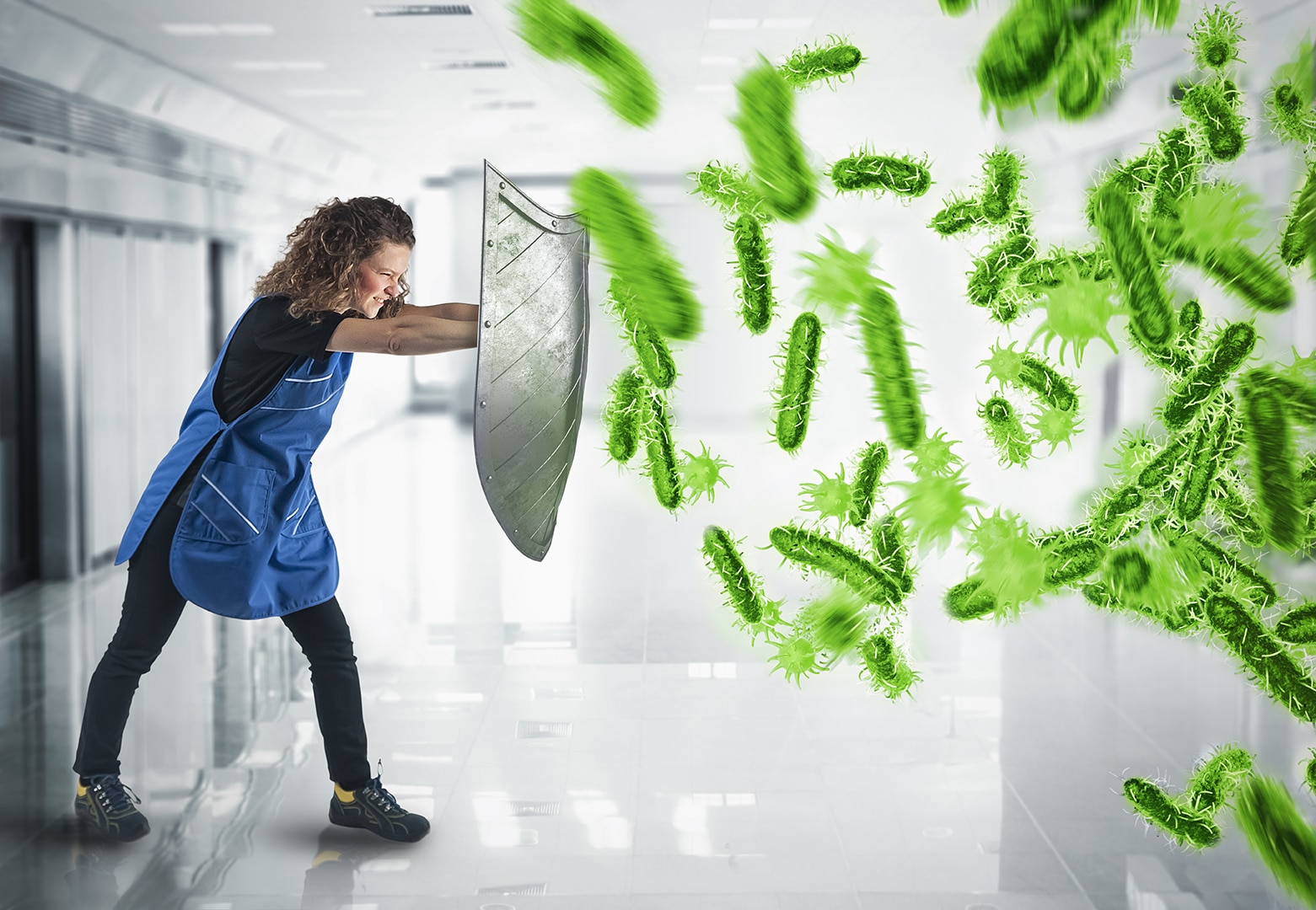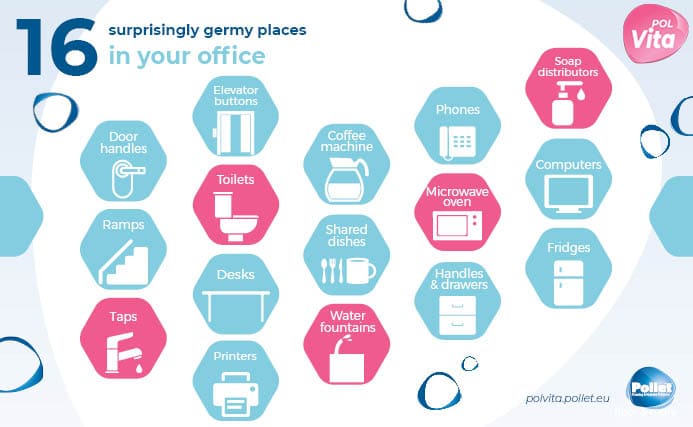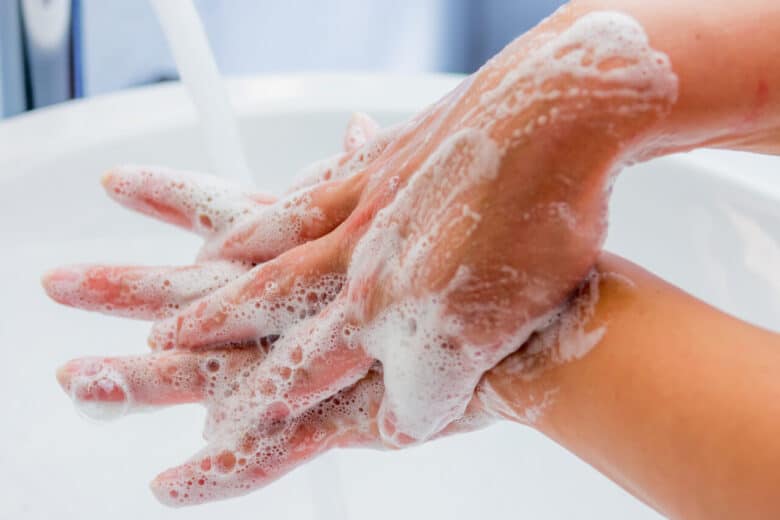
Disinfect? Yes, but that’s not all!
A clean and hygienic environment without any stress
Some companies have already resumed their activities completely or partially, others are preparing to resume. How will you best manage the hygiene of your workspaces? You could make the decision to disinfect everything, but is that really necessary? How are you going to optimize your cleaning quality, while minimizing the risk for your staff and the environment as well as the impact of the cleaning operations? Here are a few ideas.
Source: Ruhr University (Germany) study – Journal of Hospital Infection.
A well thought-out disinfection
You may be wondering why we don’t advise you to disinfect everything? It is important to know that disinfection has some flaws. Disinfection needs to be done according to a protocol that is specific for each manufacturer, which must be applied with great rigor, if not the expected results will not be achieved. Also, disinfecting materials often has an impact on the health of the users and our environment, so it is advisable to use them with caution and moderation.
- Because the lockdown has lasted for several weeks, very often the period of closure of your premises has far exceeded the lifespan of the virus on the different types of materials. Did your business come to a complete standstill from the very beginning? Then disinfecting the premises before resuming will be absolutely useless. The virus is no longer active, it is no longer present at your site. A simple cleaning will suffice.
- On the other hand, if your structure has been used even partially during the lockdown, it might be interesting to consider a well thought-out disinfection. Remember that disinfection only makes sense after a very effective cleaning.
A tailor-made action plan
Each location has its own points of consideration regarding the transmission of potential pathogens. It is necessary to make a list of all the points of contact and critical areas regarding the possible transmission of a virus or other infectious agent.
Disinfect alternately
Alternating between a cleaner and a cleaner-disinfectant has its benefits. By combining the two actions, a cleaner-disinfectant often loses part of its detergency power. This is why if it is used continuously, it could form a film and cause build-up. Therefore, alternating increases the effectiveness of cleaning while reducing the risk of toxicity for the user because, let’s not forget, a disinfectant can present more risks than a cleaner.
The frequency of this alternation will be determined depending on the type of areas that need to be cleaned and in accordance with the existing guidelines in your sector. Also note that alternating allows you to use green cleaners with more fragrance or with a longer-lasting fragrance, enzymatic cleaners or probiotic cleaners (see further down ; in this article). We are here to help you make the right choice!
Did you know that a simple, wellperformed cleaning not only removes dirt, but also eliminates up to 80% of microorganisms present on a surface?
The power of soap
Water and soap are more effective than products without water to remove dirt and microorganisms from your hands. When it is not mandatory to disinfect, soaps are an excellent alternative. In fact, using soap to wash your hands is one of the recommendations of the World Health Organization (WHO) to fight Covid-19.
Studies have shown that washing your hands is sufficient and even better than using hydroalcoholic gels. It is therefore a preferred recommendation to wash your hands with soap. This applies not only to hand soaps, but also to soapy cleaners, which have proven to be excellent for removing dirt from floors and surfaces.
Protecting with bacteria
After an effective disinfection, a surface is “freed” of all microbial life. Which means germs have free rein. The first bacterium that comes in is the first one served! Therefore, recontamination happens faster on a disinfected surface and the disinfection is quickly forgotten.
There are ways to protect surfaces with good bacteria, also called ‘probiotics’. Probiotic cleaning is actually microbial management that aims for a healthy balance in bacteria, in order to reduce the risks of harmful bacteria.
Does microbial management make disinfection unnecessary? No. The two complement each other, probiotic cleaning reduces the risk of re-contamination between two disinfections. With 25 years of expertise in the field, Pollet has been able to develop probiotic cleaners that really protect, the PolVita line. Using protective probiotic cleaners presents a dual benefit: first of all, the risk of bacterial resistance is reduced considerably, and secondly, a healthy microflora is applied to the surface. The cleaning part removes daily pollution and the probiotic bacteria ensure that “harmful” bacteria have no chance to grow on the surface.
Tests in independent laboratories have shown that beneficial bacteria continue to do their job for at least 5 days after the cleaning. So unlike disinfection, the protective probiotics in PolVita cleaners really have a long-lasting effect and therefore provide long-lasting protection.
Even though Polvita protection is essentially against unwanted bacteria, scientifics state that the use of probiotics would also help in the fight against viruses, in two ways. The first is an increased immunity against bacteria but also against viruses (this can be observed when you take probiotics orally). The second is the production of antiviral substances by probiotic bacteria.
Give yourself a wide range of choices
As you will have understood, there are many possible ways to control the risk of infection in the workplace while guaranteeing maximum hygiene and preserving the health of your employees and our environment.
For tailor-made advice, please contact our experts. We will be happy to help you develop an action plan that suits your site!



